The storm at the top of the world
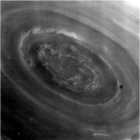 Making a close pass by the north pole of the planet Saturn – roughly the same distance as the average distance between Earth and its moon – NASA’s Cassini space probe captures unprecedented images of a hurricane-like storm vortex at the planet’s pole. With a diameter nearly as wide as the continental United States, the north polar vortex reveals vertical relief of various cloud features for the first time, and spins rapidly at the center of a hexagonal cloud feature nearly twice as wide as Earth itself.
Making a close pass by the north pole of the planet Saturn – roughly the same distance as the average distance between Earth and its moon – NASA’s Cassini space probe captures unprecedented images of a hurricane-like storm vortex at the planet’s pole. With a diameter nearly as wide as the continental United States, the north polar vortex reveals vertical relief of various cloud features for the first time, and spins rapidly at the center of a hexagonal cloud feature nearly twice as wide as Earth itself.
Cassini’s mission extended by two years
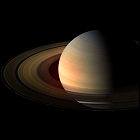 After four years orbiting the enormous ringed planet Saturn and flying past its dozens of moons, NASA’s unmanned Cassini probe still hasn’t seen it all. The four successful years thus far included releasing the European Space Agency’s Huygens probe to make the first ever landing on the large moon Titan, discovering (and flying through) water geysers over another moon, and exploring other moons that have puzzled scientists since they were first viewed up close in the early 1980s by the Voyager probes. The mission extension – called the Cassini Equinox Mission – gives Cassini an added two-year lease of life, with a $160 million price tag (the mission so far has cost both NASA and ESA a combined total of $3.3 billion).
After four years orbiting the enormous ringed planet Saturn and flying past its dozens of moons, NASA’s unmanned Cassini probe still hasn’t seen it all. The four successful years thus far included releasing the European Space Agency’s Huygens probe to make the first ever landing on the large moon Titan, discovering (and flying through) water geysers over another moon, and exploring other moons that have puzzled scientists since they were first viewed up close in the early 1980s by the Voyager probes. The mission extension – called the Cassini Equinox Mission – gives Cassini an added two-year lease of life, with a $160 million price tag (the mission so far has cost both NASA and ESA a combined total of $3.3 billion).
Huygens: first space probe to land on Titan
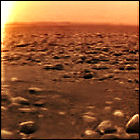 The European Space Agency’s Huygens probe successfully lands on Saturn’s largest moon, Titan, gathering measurements and taking mind-boggling images from the sky all the way down to the surface. Perhaps the biggest discovery of the initial pictures is an aerial view of what appear to be tributaries leading to a large body of liquid – an almost delta-like region as viewed from the sky. (Thanks to Titan’s thick atmospheric haze, its surface has never before been seen.) Huygens itself manages to touch down on dry land, on a plain scattered with chunks of ice, slowed to only 15 miles per hour by parachutes during its descent (despite upper-level winds estimated at around 300mph). Even if Huygens had splashed down in a body of liquid, the probe is designed to stay afloat.
The European Space Agency’s Huygens probe successfully lands on Saturn’s largest moon, Titan, gathering measurements and taking mind-boggling images from the sky all the way down to the surface. Perhaps the biggest discovery of the initial pictures is an aerial view of what appear to be tributaries leading to a large body of liquid – an almost delta-like region as viewed from the sky. (Thanks to Titan’s thick atmospheric haze, its surface has never before been seen.) Huygens itself manages to touch down on dry land, on a plain scattered with chunks of ice, slowed to only 15 miles per hour by parachutes during its descent (despite upper-level winds estimated at around 300mph). Even if Huygens had splashed down in a body of liquid, the probe is designed to stay afloat.
Cassini and the ice volcanoes of Titan!
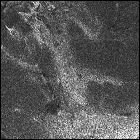 A billion miles from the sun, you don’t need molten lava for volcanoes – you just need subsurface ice to warm up and erupt as water. That’s what NASA scientists think they’ve spotted in a radar image of the surface of Saturn’s moon Titan sent back in late October by the Cassini unmanned probe. A bright, flow-like feature may be indicative of something oozing out onto Titan’s surface from below – and at the frigid temperatures experienced in Saturn’s orbit, ice volcanoes are more likely than the molten rock variety seen on Earth and Mars. If confirmed, this wouldn’t be the first “ice volcano” found in our solar system; Voyager 2 had already spotted an eruption on the surface of Neptune’s largest moon, Triton, as it swung by in August 1989.
A billion miles from the sun, you don’t need molten lava for volcanoes – you just need subsurface ice to warm up and erupt as water. That’s what NASA scientists think they’ve spotted in a radar image of the surface of Saturn’s moon Titan sent back in late October by the Cassini unmanned probe. A bright, flow-like feature may be indicative of something oozing out onto Titan’s surface from below – and at the frigid temperatures experienced in Saturn’s orbit, ice volcanoes are more likely than the molten rock variety seen on Earth and Mars. If confirmed, this wouldn’t be the first “ice volcano” found in our solar system; Voyager 2 had already spotted an eruption on the surface of Neptune’s largest moon, Triton, as it swung by in August 1989.
Cassini peers through Titan’s clouds
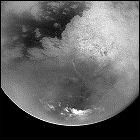 In its first close flyby of Saturn’s largest moon, the unmanned Cassini probe performs the first-ever radar reconaissance of Titan’s surface. Shrouded by a thick, organically-rich atmosphere, Titan’s surface has never been seen until now. Though scientists say that Cassini’s close pass only allows them to map 1% of the surface, the preliminary results prove to be fascinating. Titan seems, at first glance, to have a relatively smooth surface, perhaps indicating oceans, or ongoing glacial or volcanic resurfacing; a member of the radar imaging team says that readings have also indicated that the surface of Titan is “covered in organics.” Cassini will get further chances to aim its radar beams at Titan, and in December it will release the European Space Agency’s Huygens probe, which will approach Titan, ultimately entering the moon’s dense atmosphere in January to take direct readings from the surface, whether it’s solid or liquid.
In its first close flyby of Saturn’s largest moon, the unmanned Cassini probe performs the first-ever radar reconaissance of Titan’s surface. Shrouded by a thick, organically-rich atmosphere, Titan’s surface has never been seen until now. Though scientists say that Cassini’s close pass only allows them to map 1% of the surface, the preliminary results prove to be fascinating. Titan seems, at first glance, to have a relatively smooth surface, perhaps indicating oceans, or ongoing glacial or volcanic resurfacing; a member of the radar imaging team says that readings have also indicated that the surface of Titan is “covered in organics.” Cassini will get further chances to aim its radar beams at Titan, and in December it will release the European Space Agency’s Huygens probe, which will approach Titan, ultimately entering the moon’s dense atmosphere in January to take direct readings from the surface, whether it’s solid or liquid.
Cassini gets mooned at Saturn
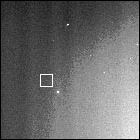 Mere weeks after entering orbit around the huge ringed planet, the Cassini is already making impressive discoveries at Saturn. NASA announces that Cassini images have uncovered two previously undiscovered moons in orbit of the ringed planet, and they’re among the smallest bodies that have yet been detected in space, each barely 2 miles in diameter. They’re given the provisional names s/2004 S1 and s/2004 S2, and await further verification of their size and orbits – and undoubtedly other members of Saturn’s family are waiting to be captured by Cassini’s cameras in the course of its planned four-year survey of the planet and its moons.
Mere weeks after entering orbit around the huge ringed planet, the Cassini is already making impressive discoveries at Saturn. NASA announces that Cassini images have uncovered two previously undiscovered moons in orbit of the ringed planet, and they’re among the smallest bodies that have yet been detected in space, each barely 2 miles in diameter. They’re given the provisional names s/2004 S1 and s/2004 S2, and await further verification of their size and orbits – and undoubtedly other members of Saturn’s family are waiting to be captured by Cassini’s cameras in the course of its planned four-year survey of the planet and its moons.
Cassini arrives at Saturn
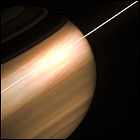 After a journey of seven years, gravity-assist slingshots past Earth, Venus and Jupiter, a plunge through Saturn’s ring-plane, and an engine burn of over an hour just to slow it down, the NASA/ESA space probe Cassini becomes the first man-made object to orbit Saturn. The trip has already paid off: Cassini has spotted never-before-seen features in Saturn’s immense rings, and succeeds in piercing Titan’s atmosphere with infrared imaging to provide one of the first-ever glimpses of the huge moon’s cloud-covered surface. Titan will also receive a visit from Cassini’s Huygens probe in 2005.
After a journey of seven years, gravity-assist slingshots past Earth, Venus and Jupiter, a plunge through Saturn’s ring-plane, and an engine burn of over an hour just to slow it down, the NASA/ESA space probe Cassini becomes the first man-made object to orbit Saturn. The trip has already paid off: Cassini has spotted never-before-seen features in Saturn’s immense rings, and succeeds in piercing Titan’s atmosphere with infrared imaging to provide one of the first-ever glimpses of the huge moon’s cloud-covered surface. Titan will also receive a visit from Cassini’s Huygens probe in 2005.
Cassini captures clumping
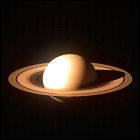 The Cassini spacecraft is close enough to Saturn to observe unusual transitory “clumps” in the planet’s ring system. First spotted by the Voyager space probes in the early 1980s, these clumps zip around Saturn’s outermost rings, following the direction of the planet’s own motion, but until now it hasn’t been possible to get close enough to study those clumps. Unlike the Voyagers, however, Cassini won’t be zipping past the planet at the speed of a bullet – it will enter an orbit around the planet in July and keep an eye on things.
The Cassini spacecraft is close enough to Saturn to observe unusual transitory “clumps” in the planet’s ring system. First spotted by the Voyager space probes in the early 1980s, these clumps zip around Saturn’s outermost rings, following the direction of the planet’s own motion, but until now it hasn’t been possible to get close enough to study those clumps. Unlike the Voyagers, however, Cassini won’t be zipping past the planet at the speed of a bullet – it will enter an orbit around the planet in July and keep an eye on things.
Cassini launched
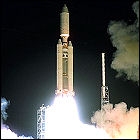 NASA/JPL’s interplanetary probe Cassini, with the European Space Agency-built Huygens Titan probe tagging along, lifts off on a Titan IV-B rocket. The voyage to Saturn will last seven years, during which Cassini does close flybys to receive gravity assists from Venus, Earth, Earth’s moon, and Jupiter en route to Saturn. It will operate in Saturn’s vicinity for over a decade and launch the Huygens probe, the first landing probe to visit a body in the outer solar system.
NASA/JPL’s interplanetary probe Cassini, with the European Space Agency-built Huygens Titan probe tagging along, lifts off on a Titan IV-B rocket. The voyage to Saturn will last seven years, during which Cassini does close flybys to receive gravity assists from Venus, Earth, Earth’s moon, and Jupiter en route to Saturn. It will operate in Saturn’s vicinity for over a decade and launch the Huygens probe, the first landing probe to visit a body in the outer solar system.
Voyager 2 at Saturn
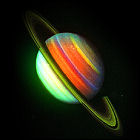 The NASA/JPL unmanned space probe Voyager 2 makes its closest pass to the planet Saturn. Unlike Voyager 1, Voyager 2 does not make a close pass to the large moon Titan, and uses Saturn’s gravity to deflect it toward the planet Uranus, the first man-made spacecraft to aim for that planet. Problems with the aiming mechanism of the scan platform – the arm of the spacecraft containing Voyager’s camera and imaging systems – call the viability of a Uranus flyby into question for a short time, but the issue is resolved and workaround procedures are developed in the event of a recurring problem.
The NASA/JPL unmanned space probe Voyager 2 makes its closest pass to the planet Saturn. Unlike Voyager 1, Voyager 2 does not make a close pass to the large moon Titan, and uses Saturn’s gravity to deflect it toward the planet Uranus, the first man-made spacecraft to aim for that planet. Problems with the aiming mechanism of the scan platform – the arm of the spacecraft containing Voyager’s camera and imaging systems – call the viability of a Uranus flyby into question for a short time, but the issue is resolved and workaround procedures are developed in the event of a recurring problem.
Voyager 1 at Saturn
 Thanks to a significant gravity assist from Jupiter, Voyager 1 arrives at Saturn only a year behind Pioneer 11, imaging the planet, its rings and its moons in far greater detail. Its planned trajectory takes Voyager 1 close to the cloud-shrouded moon Titan, whose surface scientists hope to be able to see for the first time, but the close flyby yields only the featureless clouds, much to the mission planners’ disappointment. This is Voyager 1’s final planetary stop, with a proposed visit to Pluto having fallen by the wayside early in mission planning in favor of the close-up look at Titan.
Thanks to a significant gravity assist from Jupiter, Voyager 1 arrives at Saturn only a year behind Pioneer 11, imaging the planet, its rings and its moons in far greater detail. Its planned trajectory takes Voyager 1 close to the cloud-shrouded moon Titan, whose surface scientists hope to be able to see for the first time, but the close flyby yields only the featureless clouds, much to the mission planners’ disappointment. This is Voyager 1’s final planetary stop, with a proposed visit to Pluto having fallen by the wayside early in mission planning in favor of the close-up look at Titan.
Voyager 2 and the Backup Mission Load
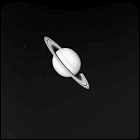 With the Jupiter encounter behind it, NASA’s Voyager 2 unmanned spacecraft is given a new backup mission plan, replacing the original Jupiter/Saturn backup plan implemented after a radio receiver failure befell the spacecraft in 1978. Intended to reap the minimum acceptable science observations (including photography) and transmit them to Earth should Voyager 2’s ability to receive new commands be lost, this new backup mission load now includes automated observation plans for Saturn and Uranus, the latter of which will not be reached until 1986.
With the Jupiter encounter behind it, NASA’s Voyager 2 unmanned spacecraft is given a new backup mission plan, replacing the original Jupiter/Saturn backup plan implemented after a radio receiver failure befell the spacecraft in 1978. Intended to reap the minimum acceptable science observations (including photography) and transmit them to Earth should Voyager 2’s ability to receive new commands be lost, this new backup mission load now includes automated observation plans for Saturn and Uranus, the latter of which will not be reached until 1986.
Pioneer 11: first visitor to Saturn
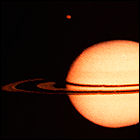 The unmanned space probe Pioneer 11 makes its closest approach to the planet Saturn, the first man-made object to visit the ringed planet. Scientists pay careful attention to Pioneer’s transmissions as it passes between Saturn’s clouds and its rings, watching for signs of damage (or worse) resulting from collision with the tiny particles that are predicted to exist there; Pioneer 11 slides past Saturn at a distance of only 12,800 miles from the planet’s cloudtops. This is Pioneer 11’s last planetary stop.
The unmanned space probe Pioneer 11 makes its closest approach to the planet Saturn, the first man-made object to visit the ringed planet. Scientists pay careful attention to Pioneer’s transmissions as it passes between Saturn’s clouds and its rings, watching for signs of damage (or worse) resulting from collision with the tiny particles that are predicted to exist there; Pioneer 11 slides past Saturn at a distance of only 12,800 miles from the planet’s cloudtops. This is Pioneer 11’s last planetary stop.
Voyager 2’s mission, should it choose to accept it…
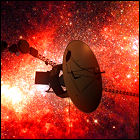 Following a communications blackout scare in April 1978, JPL uploads an autonomous command sequence to the Voyager 2 unmanned space probe, which would allow the spacecraft to carry out a self-guided mission to Jupiter and Saturn, the results of which would automatically be transmitted to Earth even if Voyager 2 can receive no further instructions from Earth. Due to the command storage limitations of Voyager 2’s onboard computer, this automatic backup mission plan makes no allowances for pictures of Jupiter, saving that capability for Saturn instead. In the event that Voyager 2 can no longer hear commands from Earth, the extended mission to Uranus and Neptune would be forfeited in favor of “minimum science return” from Jupiter and Saturn.
Following a communications blackout scare in April 1978, JPL uploads an autonomous command sequence to the Voyager 2 unmanned space probe, which would allow the spacecraft to carry out a self-guided mission to Jupiter and Saturn, the results of which would automatically be transmitted to Earth even if Voyager 2 can receive no further instructions from Earth. Due to the command storage limitations of Voyager 2’s onboard computer, this automatic backup mission plan makes no allowances for pictures of Jupiter, saving that capability for Saturn instead. In the event that Voyager 2 can no longer hear commands from Earth, the extended mission to Uranus and Neptune would be forfeited in favor of “minimum science return” from Jupiter and Saturn.
Voyaging silently onward?
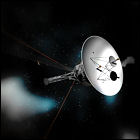 NASA’s Voyager 2 space probe, leaving the inner solar system en route to a grand tour of the outer planets, suddenly stops transmitting to Earth, failing to acknowledge commands sent by its ground controllers. Any chance of the probe conducting its studies of Jupiter and Saturn, let alone Uranus or Neptune, is in serious jeopardy. Discovering a problem with Voyager 2’s ability to compensate for the Doppler shift in signals coming from Earth, NASA engineers devise a workaround to compensate for this problem from the ground, saving the mission.
NASA’s Voyager 2 space probe, leaving the inner solar system en route to a grand tour of the outer planets, suddenly stops transmitting to Earth, failing to acknowledge commands sent by its ground controllers. Any chance of the probe conducting its studies of Jupiter and Saturn, let alone Uranus or Neptune, is in serious jeopardy. Discovering a problem with Voyager 2’s ability to compensate for the Doppler shift in signals coming from Earth, NASA engineers devise a workaround to compensate for this problem from the ground, saving the mission.
Voyaging blindly onward?
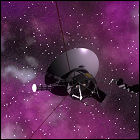 NASA’s Voyager 1 space probe, en route to its first destination, develops a potentially mission-jeopardizing problem: the scan platform, which contains and aims many of Voyager’s scientific instruments, jams and becomes stuck in place. As Voyager 1 has yet to even reach Jupiter, this threatens to make it an expensive failure. Transmitting commands from Earth to give the scan platform a gentle three-axis workout, engineers at NASA manage to free the stuck instruments, salvaging Voyager 1’s mission to the outer planets and their moons. (A similar fault develops in Voyager 2 during its 1981 encounter with Saturn.)
NASA’s Voyager 1 space probe, en route to its first destination, develops a potentially mission-jeopardizing problem: the scan platform, which contains and aims many of Voyager’s scientific instruments, jams and becomes stuck in place. As Voyager 1 has yet to even reach Jupiter, this threatens to make it an expensive failure. Transmitting commands from Earth to give the scan platform a gentle three-axis workout, engineers at NASA manage to free the stuck instruments, salvaging Voyager 1’s mission to the outer planets and their moons. (A similar fault develops in Voyager 2 during its 1981 encounter with Saturn.)
Voyager 1 leaves Earth
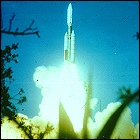 The unmanned robotic Voyager 1 space probe lifts off on a voyage to Jupiter, Saturn and beyond, taking advantage of a once-in-175-years alignment of the planets in the outer solar system. Originally designated Mariner 11, one of many planned space probes in the now greatly scaled-back Mariner Jupiter/Saturn ’77 program, Voyager 1 is also the first spacecraft to take a picture of the Earth and its moon from beyond the moon’s orbit, and will become the first human-made object to leave Earth’s solar system.
The unmanned robotic Voyager 1 space probe lifts off on a voyage to Jupiter, Saturn and beyond, taking advantage of a once-in-175-years alignment of the planets in the outer solar system. Originally designated Mariner 11, one of many planned space probes in the now greatly scaled-back Mariner Jupiter/Saturn ’77 program, Voyager 1 is also the first spacecraft to take a picture of the Earth and its moon from beyond the moon’s orbit, and will become the first human-made object to leave Earth’s solar system.
Voyager 2 launches
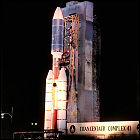 NASA launches Voyager 2 (weeks ahead of Voyager 1), giving the unmanned space probe the best shot of taking advantage of a favorable planetary alignment known as the “Grand Tour”. Using a series of carefully calculated gravity assists, Voyager has the potential to visit all four of the major outer gas planets – Jupiter, Saturn, Uranus and Neptune – in under 15 years without having to expend fuel to make the trip. If Voyager 2 survives long enough to visit Uranus or Neptune, it will become the first man-made spacecraft to visit either planet.
NASA launches Voyager 2 (weeks ahead of Voyager 1), giving the unmanned space probe the best shot of taking advantage of a favorable planetary alignment known as the “Grand Tour”. Using a series of carefully calculated gravity assists, Voyager has the potential to visit all four of the major outer gas planets – Jupiter, Saturn, Uranus and Neptune – in under 15 years without having to expend fuel to make the trip. If Voyager 2 survives long enough to visit Uranus or Neptune, it will become the first man-made spacecraft to visit either planet.
Now, Voyager
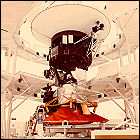 NASA Administrator James Fletcher announces that the ambitious twin Mariner Jupiter/Saturn ’77 space probes, due to be launched later in the year, have been christened with new names: Voyager 1 and Voyager 2. The name change has been initiated by recently-promoted Voyager program manager John Casani, who thinks the spacecraft need a name that’s less of a mouthful (the name “Discoverer” was also considered). For the first time, NASA openly admits that one of the vehicles – Voyager 2 – may continue on to Uranus and Neptune should its Saturn flyby go well in 1981, depending on the spacecraft’s health.
NASA Administrator James Fletcher announces that the ambitious twin Mariner Jupiter/Saturn ’77 space probes, due to be launched later in the year, have been christened with new names: Voyager 1 and Voyager 2. The name change has been initiated by recently-promoted Voyager program manager John Casani, who thinks the spacecraft need a name that’s less of a mouthful (the name “Discoverer” was also considered). For the first time, NASA openly admits that one of the vehicles – Voyager 2 – may continue on to Uranus and Neptune should its Saturn flyby go well in 1981, depending on the spacecraft’s health.
Pioneer 11 launched
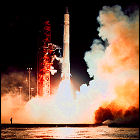 The unmanned space probe Pioneer 11 is launched on a course that will be one of the first real tests of the theory of gravity assist. Reaching Jupiter in 1975, it will use the giant planet’s gravity to throw it across the solar system to rendezvous with Saturn, the first human-made vehicle to visit that planet. The experience gained with Pioneer 11’s groundbreaking trajectory through the solar system will prove instrumental in the upcoming Mariner Jupter/Saturn ’77 mission, which is later be renamed Voyager.
The unmanned space probe Pioneer 11 is launched on a course that will be one of the first real tests of the theory of gravity assist. Reaching Jupiter in 1975, it will use the giant planet’s gravity to throw it across the solar system to rendezvous with Saturn, the first human-made vehicle to visit that planet. The experience gained with Pioneer 11’s groundbreaking trajectory through the solar system will prove instrumental in the upcoming Mariner Jupter/Saturn ’77 mission, which is later be renamed Voyager.
Mariner Jupiter/Saturn ’77
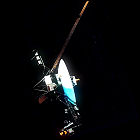 Having spent six years wrangling with various mission profiles for a “Grand Tour” of the outer solar system, made possible by a favorable planetary alignment occurring only once every 175 years, NASA finally authorizes a very stripped-down version of its original ambitious Grand Tour plans. The Mariner Jupiter/Saturn ’77 mission will consist of two twin unmanned spacecraft to be launched in 1977, each on a course to explore Jupiter, and then to use Jupiter’s gravity to deflect them to Saturn. These spacecraft will be renamed Voyager 1 and Voyager 2 just a few months before lifting off.
Having spent six years wrangling with various mission profiles for a “Grand Tour” of the outer solar system, made possible by a favorable planetary alignment occurring only once every 175 years, NASA finally authorizes a very stripped-down version of its original ambitious Grand Tour plans. The Mariner Jupiter/Saturn ’77 mission will consist of two twin unmanned spacecraft to be launched in 1977, each on a course to explore Jupiter, and then to use Jupiter’s gravity to deflect them to Saturn. These spacecraft will be renamed Voyager 1 and Voyager 2 just a few months before lifting off.
Epimetheus
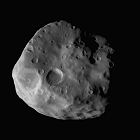 Just days after the discovery of a satellite in a near-identical orbit, U.S. Naval Observatory astronomer Richard Walker discovers Epimetheus, another natural satellite of the planet Saturn, again orbiting just beyond the outer edge of Saturn’s ring. Many of Walker’s fellow astronomers believe this is merely a second sighting of Janus, discovered mere days before, but irregularities in the computed orbits vex astronomers well into the 1970s, at which point it is conceded that the observations are best explained by two satellites in a very close orbit to one another. Epimetheus and Janus will next be spotted by Voyager 1 in 1980, conclusively proving the existence of two bodies. Epimetheus’ name won’t be made official until 1983. (Epimetheus is shown here in a 21st century Cassini photo.)
Just days after the discovery of a satellite in a near-identical orbit, U.S. Naval Observatory astronomer Richard Walker discovers Epimetheus, another natural satellite of the planet Saturn, again orbiting just beyond the outer edge of Saturn’s ring. Many of Walker’s fellow astronomers believe this is merely a second sighting of Janus, discovered mere days before, but irregularities in the computed orbits vex astronomers well into the 1970s, at which point it is conceded that the observations are best explained by two satellites in a very close orbit to one another. Epimetheus and Janus will next be spotted by Voyager 1 in 1980, conclusively proving the existence of two bodies. Epimetheus’ name won’t be made official until 1983. (Epimetheus is shown here in a 21st century Cassini photo.)
Janus
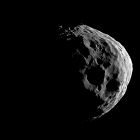 French astronomer Audouin Dollfus discovers Janus, the tenth discovered natural satellite of the planet Saturn, orbiting just beyond the outer edge of Saturn’s ring. Confusion is caused when, mere days later, an American astronomer discovers another body in a near-identical orbit that cannot be reconciled with the orbit calculated for Janus. Only in the late 1970s will a theory emerge that explains the inconsistencies as the presence of two moons moving around Saturn as a co-orbital pair, occasionally swapping positions. Janus’ existence will be verified in 1980 by Voyager 1. (Janus is shown here in a 21st century Cassini photo.)
French astronomer Audouin Dollfus discovers Janus, the tenth discovered natural satellite of the planet Saturn, orbiting just beyond the outer edge of Saturn’s ring. Confusion is caused when, mere days later, an American astronomer discovers another body in a near-identical orbit that cannot be reconciled with the orbit calculated for Janus. Only in the late 1970s will a theory emerge that explains the inconsistencies as the presence of two moons moving around Saturn as a co-orbital pair, occasionally swapping positions. Janus’ existence will be verified in 1980 by Voyager 1. (Janus is shown here in a 21st century Cassini photo.)
The Grand Tour
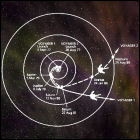 The Grand Tour Outer Planets mission is proposed to NASA by the Jet Propulsion Laboratory. Using a combination of the gravitational assist trajectories computed by JPL’s Michael Minovitch in 1961, Caltech/JPL grad student Gary Flandro has identified a favorable alignment of the outer planets which would allow for a single spacecraft to reach Jupiter, Saturn, Uranus, Neptune and Pluto within two decades. Vehicles taking advantage of this planetary alignment must lift off at very precise times during 1977 and 1978, and the alignment will not occur again for nearly 200 years. An ambitious plan is laid out for multiple flyby vehicles with atmospheric probes for every gas planet and landers for specific moons of interest, launched by Saturn V rockets. Budget realities scale this plan back: flybys will be carried out by two cheaper Mariner vehicles (later renamed Voyager), while the atmospheric and satellite probes – eventually to be renamed Galileo and Cassini – wait even longer to reach their destinations, and the Pluto flyby is scrapped until the 21st century New Horizons probe lifts off. JPL also recommends an inner solar system tryout of the gravitational assist maneuvers required, resulting in the Mariner 10 mission to Venus and Mercury.
The Grand Tour Outer Planets mission is proposed to NASA by the Jet Propulsion Laboratory. Using a combination of the gravitational assist trajectories computed by JPL’s Michael Minovitch in 1961, Caltech/JPL grad student Gary Flandro has identified a favorable alignment of the outer planets which would allow for a single spacecraft to reach Jupiter, Saturn, Uranus, Neptune and Pluto within two decades. Vehicles taking advantage of this planetary alignment must lift off at very precise times during 1977 and 1978, and the alignment will not occur again for nearly 200 years. An ambitious plan is laid out for multiple flyby vehicles with atmospheric probes for every gas planet and landers for specific moons of interest, launched by Saturn V rockets. Budget realities scale this plan back: flybys will be carried out by two cheaper Mariner vehicles (later renamed Voyager), while the atmospheric and satellite probes – eventually to be renamed Galileo and Cassini – wait even longer to reach their destinations, and the Pluto flyby is scrapped until the 21st century New Horizons probe lifts off. JPL also recommends an inner solar system tryout of the gravitational assist maneuvers required, resulting in the Mariner 10 mission to Venus and Mercury.
Gravitational assist
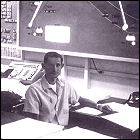 Recent Jet Propulsion Laboratory hire Michael Minovitch submits the first of a series of papers and technical memorandums on the possibility of using carefully-calculated gravitational assist maneuvers to speed transit time between celestial bodies while requiring minimal engine/fuel use. Where most previous scientific thought concentrated on using engine burns (and a lot of fuel) to cancel the effects of a planet’s gravity, Minovitch demonstrated that gravity could be a big help with a carefully calculated trajectory. Though nearly every planetary mission since then has capitalized on Minovitch’s research, it was initially rejected by JPL. Minovitch’s calculations are later revisited by Caltech grad student Gary Flandro, who flags down a particular combination of Minovitch’s pre-computed trajectories for a “grand tour” of the outer solar system, a mission which will eventually be known – in a somewhat scaled-down, less grand form – as Voyager.
Recent Jet Propulsion Laboratory hire Michael Minovitch submits the first of a series of papers and technical memorandums on the possibility of using carefully-calculated gravitational assist maneuvers to speed transit time between celestial bodies while requiring minimal engine/fuel use. Where most previous scientific thought concentrated on using engine burns (and a lot of fuel) to cancel the effects of a planet’s gravity, Minovitch demonstrated that gravity could be a big help with a carefully calculated trajectory. Though nearly every planetary mission since then has capitalized on Minovitch’s research, it was initially rejected by JPL. Minovitch’s calculations are later revisited by Caltech grad student Gary Flandro, who flags down a particular combination of Minovitch’s pre-computed trajectories for a “grand tour” of the outer solar system, a mission which will eventually be known – in a somewhat scaled-down, less grand form – as Voyager.